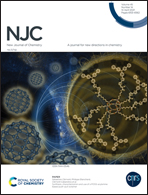A highly efficient bifunctional electrocatalyst (ORR/OER) derived from GO functionalized with carbonyl, hydroxyl and epoxy groups for rechargeable zinc–air batteries†
Abstract
Electrocatalysts play an important role in fuel cells, metal–air batteries, and water-splitting devices. The development of low-cost, high-activity, and high-performance bifunctional electrocatalysts for the ORR and OER is a research hotspot. Herein, a N/S codoped functionalized graphene bifunctional catalyst was developed and successfully applied to zinc–air batteries. Graphene oxide was used as a starting material, and its carbonyl, hydroxyl, and epoxy groups have been fully utilized. Doping with nitrogen and sulfur changed the electronic properties of graphene, and charge transfer caused by doping promoted the adsorption and dissociation of oxygen, induced the production of active sites, and enhanced the intrinsic activity, thus improving the electrocatalytic performance. In 0.1 M KOH, the half-wave potential of Co–N/S/rGO is 870 mV, which is higher than that of Pt/C (829 mV). Rotating ring disk testing also shows that this system is close to a four-electron transfer reaction system, and the formation rate of H2O2 is very low (<5%). In addition, Co–N/S/rGO also showed excellent catalytic performance in the OER, with an overpotential of 320 mV at a current density of 10 mA cm−2, which was slightly worse than that of RuO2 (290 mV). The excellent catalytic performance is attributed to the charge redistribution caused by N and S doping, and the abundant CoNx active sites. A rechargeable liquid zinc–air battery based on the Co–N/S/rGO catalyst had a high open circuit voltage (1.49 V) and galvanostatic discharge capacity (2320 min, 5 mA cm−2). Under the same conditions, the OCV of Pt/C + RuO2 is 1.43 V, and its galvanostatic discharge capacity is only 730 min at 5 mA cm−2. Moreover, the peak power density of Co–N/S/rGO (66.6 mW cm−2) is much higher than that of Pt/C + RuO2 (26.3 mW cm−2).



 Please wait while we load your content...
Please wait while we load your content...